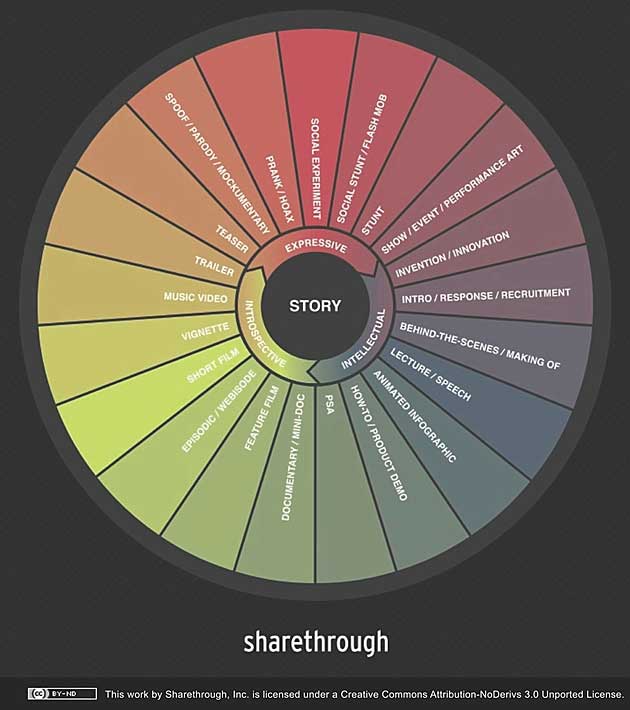We know why people share content online. Studies have revealed the reasons. Roughly speaking, we share content because (1) we want to amaze and entertain our friends; (2) we want to reveal aspects of our true selves to friends so as to build stronger relationships; and (3) we want to help people by providing them with valuable information and insight.
Each of those reasons implies that the content makes enough of a personal, emotional connection with viewers that it compels them to act as agents of distribution, with the result being a more positive self-image for them.
So, what's the best way to establish such connections with the viewer? Storytelling.
Good stories engage us, seduce us, and recruit us; they open our minds to accept whatever message the creator wants to convey. Consequently, a good story should lie at the heart of every piece of video content.
However, a great story does not guarantee success. As it turns out, the genre of video you produce plays a large role in determining whether your campaign goals will be met.
The following graphic offers a simple framework for determining the ideal genre of video to produce to most effectively communicate your marketing message. The genres group into three categories—expressive, impressive, and intellectual—nicely corresponding to the three reasons people share content.

(Also see the interactive version of the graphic.)
So... which genres of videos work best for which types of campaign goals?
1. For a big splash, aim to provoke or thrill
Expressive videos are stimulating and provocative. They trigger visceral expressions of emotion by thrilling us, tricking us, cracking us up, or performing for us. Because they are contagiously fun, such videos allow us to amaze and entertain our friends. That's why many viral videos are from this category.
For example, The Gymkhana series of videos, which are driving stunts, have been watched over 100 million times. Pepsi Max's "Uncle Drew," with more than 22 million views, was a hoax. TNT's "Dramatic Surprise" in Belgium has over 44 million views. The list goes on and on.
These are the types of videos that spread most efficiently and can be counted on for loads of earned media. If your goal is to make a big splash, these are the types of videos you should make.
2. To bond with your audience, impress them
Impressive videos are emotional and deliberate. They tell stories, reveal character, and use metaphors. Impressive videos are well-crafted and engaging. In sum, they leave a thoughtful impression, which we can use to define ourselves to our friends. Impressive videos, when done well, entice people to watch them—sometimes again and again—but they don't spread as easily as expressive videos.
That said, videos that are more cerebral and nuanced can reflect a brand's complex understanding of their consumers and can make people feel a stronger bond for their product.
For example, Beyonce released a music video for World Humanitarian Day. The video is thought-provoking and touching, leaving the viewer informed about the significance of the day itself and inspired to make the world a better place.
3. If your goal is education, go for intellectual videos
Intellectual videos are enlightening and meaningful. They teach us something new. They offer insights and challenge how we see things and do stuff. They have a practical purpose that leaves us wiser. Forwarding them to friends can make you a hero—or a provocateur, because these videos can occasionally be controversial.
These types of videos can stay relevant for years, and you could have multiple instances of traffic spikes.
Though they are not as inherently viral as expressive videos, intellectual videos can hit the perfect note by distilling an idea or a topic to its essence. A great example is a McDonald's video explaining why burgers always look better on TV than they do in real life.
That thoughtful behind-the-scenes look at a McDonald's photo shoot took the time to walk us through the process of making an over-the-counter burger ready for its close-up, respectfully appealing to our sense of reason in considering a topic about which many of us have had suspicions.
* * *
This three-part framework can also be used to consider the similarities and differences one video genre might have in regard to another. For example, if you've had success producing hoaxes, it's probably worth trying to create some sort of spoof or parody since many of the same skills go into both.
The freedom to produce branded video content in any genre is a great creative advantage, but with that freedom comes the responsibility of choosing the most effective genre to achieve your stated goals. Each genre has its built-in strengths and weaknesses. Know when and why to choose each.




